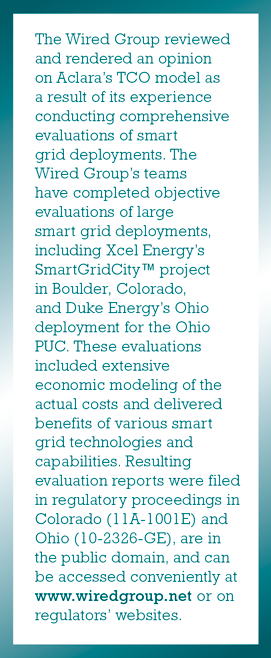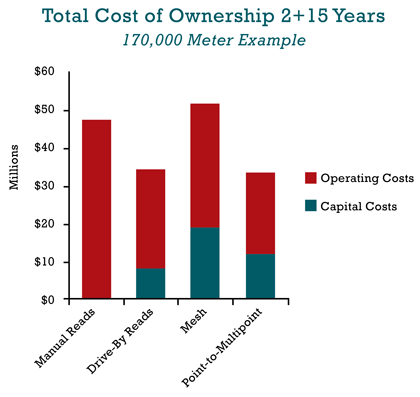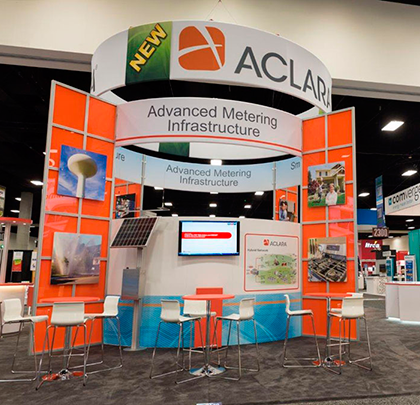Electric utilities are undergoing a transformation not seen since the Tennessee Valley Authority brought electricity to rural America. The complex challenges facing electric distribution utilities range from aging infrastructure, the fall of coal, the rise of distributed energy resources and microgrids; consumer pressures for more and better energy-use information; regulatory requirements for improved pricing model and workable energy efficiency and demand-response programs.
To meet these regulatory and consumer requirements, electric utilities today are collecting more data from meters as well as other edge devices on their distribution networks. Yet, many utilities today put more emphasis on the cost of meters rather than the long-term returns of collecting data from these devices. In fact, many utilities making decisions on how to collect data from meters and edge devices rely on historic preferences as well as older models that focus only on the short-term capital costs related to acquiring and deploying meters.
However, the long-term capital and operating expenses related to reading meters are important cost drivers for a utility. These expenses vary considerably depending on the method used—whether manually by meter readers, by drive-by systems that wirelessly read devices from service vehicles, or via a fixed network that collects data automatically. As a result, evaluation of new systems needs to be based on a macro, longer-term view to assess the greatest return on investment and the potential for system and service improvements.
This report summarizes the findings of a recent study conducted by the Wired Group, which indicates that the choice of meter communication network is a critical decision when determining the TCO of a meter-reading network over time.
This report describes how utilities can apply TCO evaluation, which takes into account on-going operations costs, replacement and lifecycle costs and personnel, as well as initial capital investment, to get a more complete picture of what systems will actually cost over time. These TCO calculations prove that point-to-multipoint fixed-network solutions can provide the best TCO of any competitive system, including manual, drive-by or mesh fixed network solutions.
Another key finding is that current point-to-multipoint technologies may facilitate data collection from meters and other edge devices in support of AMI, as well as smart infrastructure solutions such as load control and distributed automation more effectively than other types of networks. In addition, the architecture of modern point-to-point fixed networks eliminates latency issues (characteristic of mesh networks) which slow the collection and delivery of data. Plus, point-to-multipoint networks exhibit additional benefits in outage restoration, Volt/ VAR optimization and in communications with hard-to-reach meters.

METHODOLOGY AND MODEL VALIDATION
Aclara developed a TCO model and engaged the Wired Group to make recommendations on how it could enhance its model and to validate its accuracy and its general value for utilities making decisions about advanced meters and communications networks. As part of the validation process, the Wired Group looked at the drivers affecting point-to-multipoint and mesh fixed networks, as well as drive-by and walk-by systems.
The Wired Group performed several tasks to inform its recommendations to Aclara, which included:
- Evaluation of the experiences of dozens of for-profit and non-profit utilities regarding deployed meter communications networks of various types through telephone interviews and research of regulatory filings and other publicly-available information.
- Investigations of technical product specifications available from suppliers of various meter communications network types.
- Interviews to collect validating information were done with investor-owned utilities, municipal and rural electric cooperatives ranging in size from 30,000 to more than five million endpoints. The interviews also identified the geographic reach of the installation, the type of communications network and backhaul installed at each location, and the number of data collection and transfer points including bridges, repeaters and router used. Also evaluated were the success rates of automated meter reading and service order completion. In addition, utilities were asked whether they used the data collected in outage management and distributed automation.
Wired Group issued an opinion letter verifying its work and findings at the project completion. The opinion letter concluded the Aclara TCO model fairly and accurately compares the TCO of various metering and communications scenarios to one another, specifically when evaluating manual and drive-by meter reading and full AMI deployment using mesh or point-to-multipoint fixed networks.
MAJOR COST DRIVERS AND THE TCO MODEL
The Wired Group’s research established that capital costs and continuing operating expenses for both meters and the communications network are both important smart grid cost drivers for utilities.
Capital costs for meter reading include meter replacement, module installation if there is no meter replacement, remote connect/disconnect switches and back-office software including the headend and meter data management. Continuing operating expenses for meter reading are determined by how the meters are read, with the highest costs related to walk-by meter reading and the lowest related to advanced metering infrastructure (AMI).
Capital costs affecting the communications network include meter-module costs, number of meters per data collector unit (DCU), installed costs per DCU, the costs of back-office software and hardware, number of meters per router, bridge (or repeater) and installed costs per router, repeater or bridge.
Factors influencing the ongoing operating expenses of the communications network are the number of meters read per month, the number of service orders handled per month, the cost of truck rolls, fully loaded average annual cost per communications network employee, automated meter read success rate, automated service order success rate, meters per communications network employee, annual data backhaul cost per DCU per month, and annual software licensing and maintenance fees.

HOW THE MODEL WORKS
The Aclara model fully encompasses the determinants described above and allows comparison of walk-by, drive-by, mesh and point-to-multipoint AMI networks.
The model also takes into account the potential savings afforded to utilities that use fixed network systems for implementation of time-varying rates, reduction of theft and nonrevenue losses and deployment of prepayment programs.
Utility inputs for the networks, verified through interviews, are used as the basic input to the model. All data inputs, whether related to mesh or point-to-multipoint data networks can be changed in the model to more accurately reflect the utility’s individual case.
The model is designed to predict TCO over a two-year deployment, followed by a fifteen-year project life span. The figure below illustrates a comparison using input collected during the model-validation process conducted by the Wired Group; capital and operational expenditures are compared.
If a utility chooses to make no change from manually reading meters, then its operational costs will continue to grow linearly. If the utility has converted to a drive-by solution it can reduce operations costs over manual reading, but over time this figure still increases. When a utility moves to a point-to-multipoint solution, ongoing operations and maintenance costs drop; this effectively fulfills a utility’s business case to implement a more modern and efficient meter data collection method.
A LOOK AHEAD
In next month’s conclusion to this article, we’ll take a closer look at the effect of network selection on ongoing costs. We’ll see that point-to-multipoint networks may integrate outage reports from meters into their outage management systems (OMSs) better than utilities using mesh networks. ◆
For More Information: Paul Alvarez, president of the Wired Group, can be reached at 303.997.0317 ext. 801. Todd Ellis is a product manager for Aclara and
can be reached at 314.895.6443. For help with using the model to improve
meter-related decision-making, please contact Ellis or your Aclara
representative. Aclara is a worldclass supplier of smart infrastructure
solutions (SIS) to more than 780 water, gas, and electric utilities
globally. Aclara SIS offerings include smart meters and other field devices,
advanced metering infrastructure and software and services that enable
utilities to predict and respond to conditions, leverage their distribution
networks effectively and engage with their customers. For more
information, visit www.aclara.com.
____________________________________________
MODERN PUMPING TODAY, December 2016
Did you enjoy this article?
Subscribe to the FREE Digital Edition of Modern Pumping Today Magazine!
![]()


